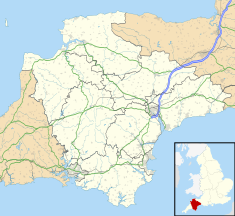
Tavistock is an ancient stannary and market town within West Devon, England. It is situated on the River Tavy from which its name derives. At the 2011 census the three electoral wards had a population of 13,028. It traces its recorded history back to at least 961 when Tavistock Abbey, whose ruins lie in the centre of the town, was founded. Its most famous son is Sir Francis Drake.

The Hazlitt Theatre and Exchange Studio, also known as the Hazlitt Arts Centre, is a theatre complex in Earl Street in Maidstone, Kent, England. The oldest part of the complex, which is now used as a shopping complex on the ground floor, and as a theatre venue known as the "Exchange Studio" on the first floor, is a Grade II listed building.

The Palace Theatre & Grand Hall Complex is a multi-purpose entertainment arena complex in Green Street, Kilmarnock, Scotland. The structure, which was originally opened as a corn exchange, is a Category A listed building.

Corn exchanges are distinct buildings which were originally created as a venue for corn merchants to meet and arrange pricing with farmers for the sale of wheat, barley, and other corn crops. The word "corn" in British English denotes all cereal grains, such as wheat and barley. With the repeal of the Corn Laws in 1846, a large number of corn exchanges were built in England, particularly in the corn-growing areas of Eastern England.

Stourbridge Town Hall is a municipal building in Market Street, Stourbridge, West Midlands, England. The town hall, which was the headquarters of Stourbridge Borough Council, is a Grade II listed building.

Tavistock Town Hall is a municipal building in Bedford Square, Tavistock, Devon, England. The structure, which remains the main venue for civic events in the town, is a Grade II listed building.

The Corn Exchange is a commercial building on Fore Street in Hertford, Hertfordshire, England. The structure, which is currently used as an events venue, is a Grade II listed building.

The Corn Exchange is a commercial building in Tuesday Market Place, King's Lynn, Norfolk, England. The structure, which was commissioned as a corn exchange and is now used as an events venue, is a Grade II listed building.

The Market House is a commercial building in Church Street in Camborne, Cornwall, England. The structure, which is currently used as a hotel and public house, is a Grade II listed building.

The Corn Exchange is a commercial building in Gloucester Street in Faringdon, Oxfordshire, England. The structure, which is currently used as a community events venue, is a Grade II listed building.

The Corn Exchange is a commercial building in Queen Street, Market Rasen, Lincolnshire, England. The structure, which is used as the offices of a firm of charted surveyors, is a Grade II listed building.

The Corn Exchange is a commercial building in the Market Place, Wallingford, Oxfordshire, England. The structure, which is used as a theatre, is a Grade II listed building.

The Corn Exchange is a commercial building in the Market Place, Fakenham, Norfolk, England. The structure, which is currently used as a cinema, is a Grade II listed building.

The Corn Exchange is a commercial building in the Corn Market, Romsey, Hampshire, England. The structure, which is has been used extensively as a bank branch, is a Grade II* listed building.

The Corn Exchange is a commercial building in the Market Place, Kettering, Northamptonshire, England. The structure, which was used as a cinema for much of the 20th century, currently accommodates a restaurant.

The Corn Exchange is a commercial building in Broad Street, Stamford, Lincolnshire, England. The structure was refurbished between 2001 and 2008 and is now used as a theatre.

The Corn Exchange is a commercial building in Sincil Street, Lincoln, Lincolnshire, England. The structure, which is now used as a restaurant and shops, is a Grade II listed building.

The Corn Exchange is a commercial building in the High Street in Ross-on-Wye, Herefordshire, England. The structure, which is now used as a bookshop and as the offices of Ross-on-Wye Town Council, is a Grade II listed building.

The Corn Exchange is a commercial building in the Market Place in Alford, Lincolnshire, England. The structure, which is currently used as a community events venue, is a Grade II listed building.

The Old Town Hall is a municipal building in St Mary Street, Newport, Shropshire, England. The structure, which is now divided into a series of shop units on the ground floor and used as a children's play area on the first floor, is a Grade II listed building.





















